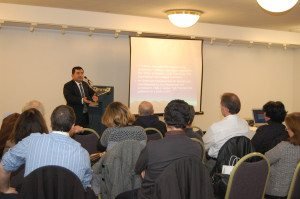NEW YORK—Dr. Vartan Matiossian presented a lecture titled “The Aryan Myth, Hitler, and the Armenians,” in an event hosted by the Zohrab Center at the Diocesan Complex in New York City on Thurs., Dec. 1.

Tracing the definition of the origins of the “Aryan” race in particular, Matiossian began his remarks with an overview of the concepts of race and language since the late 18th century. The concept of the “Aryan Myth” emerged in the late 19th century, he explained, and contrary to opinions of the time it is now considered a purely linguistic term.
He cited examples of European poets and journalists who were quoted as representing Armenians in an unfavorable light, including the French poet Alphonse de Lamartine and the British journalist S.A. Longworth. After a visit to Constantinople in 1835, Lamartine had written: “Like the Swiss of Europe, they are laborious, peaceful, and regular; but, like them, they are calculating and avaricious…. There is nothing heroic or warlike in their nature. Commerce is their deity: They would pursue it under any master.”
Matiossian spoke about general attitudes of the time, including rising anti-Semitism and negative views of Armenians. Like Jews, Armenians were perceived as swindling money changers, merchants, and bankers. Such a view was widespread throughout Europe, including Germany, which had set expansionist designs over the Ottoman Empire at the end of the 19th century. In 1898, the best-selling German novelist Karl May, who would go on to become one of Hitler’s favorite writers, warned that Armenians were not to be trusted.
This was compounded by anti-Armenian sentiments in Turkey at the close of the 19th century. Bishop Grigoris Balakian, who survived the Armenian Genocide by disguising himself as a German worker, later wrote that the Germans officers he worked with had commented that Armenians were “Christian Jews” and “bloodsucking usurers of the Turkish people.”
With the rise of Nazism in Germany, such sentiments became a stereotype. Hitler was particularly keen on eliminating ethnic minorities in Germany. Focusing his attention on the purported purity of the Aryan race, he strove to remove Jews, Gypsies, and other undesirables from the German nation. As early as 1922, he considered Armenians a “mixed race,” according to a 1922 interview.
Matiossian pointed out that after the introduction of the Aryan Laws in 1933, Armenians lobbied to have themselves officially recognized as Aryan, for their putative identification with Jews could have turned them into a target. This did not stop identifications in the press and scholarship, however. During the 1938 Kristallnacht pogroms, Matiossian said, Armenians seem to have also been targeted, probably confused with Jews.
He then went on to explain how Armenians successfully lobbied against this dangerous classification after the outbreak of World War II, when German authorities seemed one more time to be leaning toward considering Armenians as Semites. Most of this work was carried out through the German-Armenian Society, which had been established in 1914. Around 1942-43, despite contradictory signals from German officials, Armenian efforts resulted in ensuring the safety of the Armenian population in Germany and occupied territories.
Matiossian is the executive director of the Armenian National Education Committee in New York. He is a native of Montevideo, Uruguay, and earned his Ph.D. in history from the National Academy of Sciences in Armenia. He is the author of 5 books in Armenian and 1 in Spanish, and has translated 13 books from Armenian into Spanish.


This no sense make article is does.
I’m shocked to see this sort of double-speak. Far be it for me to claim sympathy for German warmongering regimes of any sort, much
less the Hitlerian double-edged sword for us Armenians, but this article, and perhaps Matossian’s so-called arguments, make no sense.
We are to believe that the overall climate was anti-Armenian and that due to this anti-Armenian climate AND Hitler’s alleged
“long-time anti-Armenianness expressd in interviews) anti-Armenianness, the Armenians were able to successfully lobby to be included
in the Aryan race.
Fascinating.
Please, Armenians, stay out of the race politics and stick to nationalism. You’ll be more credible.
I can’t comprehend the previous comment.
But I would remind that the legendary founder of the Armenian nation, Hayk Nahapet, was the son of Togormah, Noha’s descendant. That makes Armenians Semitic.
“Hayk Nahapet, was the son of Togormah, Noha’s descendant. That makes Armenians Semitic.”
You are wrong. In your statement, you’re implying that Noah was Semitic and if that was the case, then everyone in the whole world would be Semitic.
I will remind you that Semites are the descendants of Noah’s son Shem. Armenians are not descendants of Shem.
According to the story. In the Biblical view, the listed children of Japheth, Shem and Ham correspond to various historic nations and peoples. In the typical interpretation, these sons of Noah correspond to three races: European, Semitic, and African. Alternate divisions claim Euro-Asian Japhet, Semitic Shem, and Afro-Asian Ham.
I don’t know what the much older Sumerian, Babylonian versions of the great flood say about this.